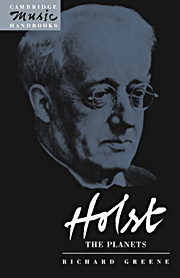1 - Holst and the two Londons
Published online by Cambridge University Press: 21 November 2009
Summary
When Gustav Holst came up to London from the West Country in 1893, he entered a world far removed from provincial life. There were, perhaps, always two Londons for the young Holst: the rather formal environment of the Royal College of Music and the kaleidoscopic world of Hammersmith where he lodged as a student. The first concentrated him on serious music and the past; Charles Villiers Stanford, his composition teacher at the College, enclosed his students in a world view culminating in the music of Brahms. The second world was filled with a happy and perhaps vulgar culture; music halls, varieties and all forms of popular music. He appears to have happily kept a foot in both camps, for the two worlds are often found side by side in his music, and the tension between the two was a fundamental influence as the composer forged his personal style.
These two worlds were, in reality, but two aspects of Victorian London, highbrow and lowbrow. Edwardian London, with its rising middle class, was characterized by a merging of these two cultural strains, giving birth to a wellcrafted popular style and the potential for the language of the folktune and the sentimental ballad to be molded into a more intense and serious artistic statement.
There was a gap of seven years between the time Holst began work on The Planets and the first public performance in 1920, meaning that it was conceived in a London clinging to a fast fading Edwardian spirit, but born and raised in the new world of post-war Europe.
- Type
- Chapter
- Information
- Holst: The Planets , pp. 9 - 17Publisher: Cambridge University PressPrint publication year: 1995



